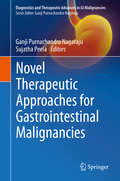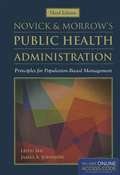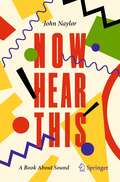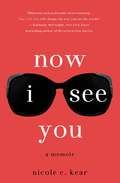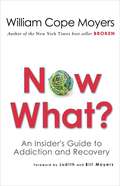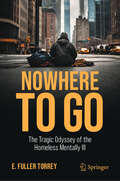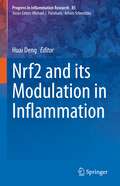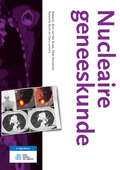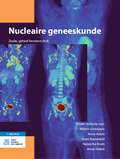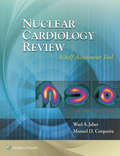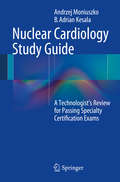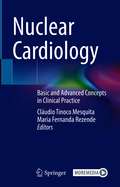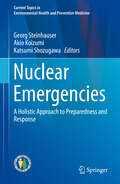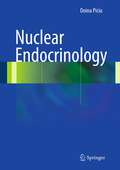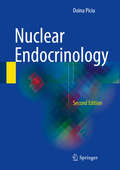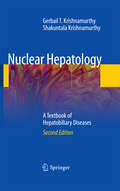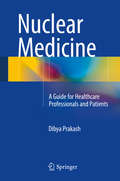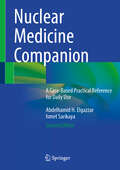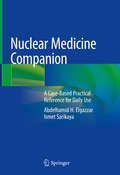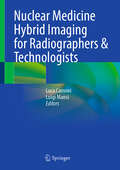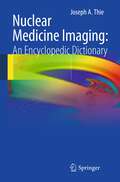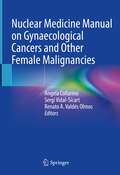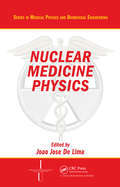- Table View
- List View
Novel therapeutic approaches for gastrointestinal malignancies (Diagnostics and Therapeutic Advances in GI Malignancies)
by Ganji Purnachandra Nagaraju Sujatha PeelaThis book provides an up-to-date overview of gastrointestinal malignancies, including prevention, early detection, intervention, and life-extending therapeutics. It also assesses various biomarkers used for diagnostics, prognostics and prediction of response to chemoresistance. Further, it discusses the latest trends in the use of small-molecule targeted therapies and immunotherapies as single agents or combination with other treatments. Since resistance to radiation and chemotherapy contribute to the high recurrence and poor survival rates, improving the outcome for GI malignancies is dependent on the introduction of new biomarkers and therapeutic agents. Lastly, the book systematically investigates novel theranostics approaches using nanotechnology for the detection, diagnosis, and personalized treatment of GI malignancies.
Novick & Morrow's Public Health Administration: Principles for Population-Based Management (Third Edition)
by James Johnson Leiyu ShiWith contributions from experts in areas ranging from workforce to community-based prevention to emergency preparedness, this thoroughly revised edition offers detailed, comprehensive coverage of current, relevant issues for new as well as seasoned public health administrators.
Now Hear This: A Book About Sound
by John NaylorThis book explains the nature of sound both as a physical phenomenon and as a sensation, how it travels through air and water, and how the hearing system evolved to convert these vibrations into sensations. Drawing on physics, biology, neuroscience, philosophy, literature, history, anecdote, and personal experience, "Now Hear This" is a wide-ranging exploration of the nature of sound and hearing that opens up a fascinating world of sounds from the mundane to the unusual and seeks above all to persuade the reader of the wisdom of John Cage’s advice that “Wherever we are what we hear is mostly noise. When we ignore it, it disturbs us. When we listen to it, we find it fascinating.”
Now I See You: A Memoir
by Nicole C. Kear<P>At nineteen years old, Nicole C. Kear's biggest concern is choosing a major--until she walks into a doctor's office in midtown Manhattan and gets a life-changing diagnosis. She is going blind, courtesy of an eye disease called retinitis pigmentosa, and has only a decade or so before Lights Out. Instead of making preparations as the doctor suggests, Kear decides to carpe diem and make the most of the vision she has left. She joins circus school, tears through boyfriends, travels the world, and through all these hi-jinks, she keeps her vision loss a secret. <P>When Kear becomes a mother, just a few years shy of her vision's expiration date, she amends her carpe diem strategy, giving up recklessness in order to relish every moment with her kids. Her secret, though, is harder to surrender - and as her vision deteriorates, harder to keep hidden. As her world grows blurred, one thing becomes clear: no matter how hard she fights, she won't win the battle against blindness. But if she comes clean with her secret, and comes to terms with the loss, she can still win her happy ending. <P>Told with humor and irreverence, Now I See You is an uplifting story about refusing to cower at life's curve balls, about the power of love to triumph over fear. But, at its core, it's a story about acceptance: facing the truths that just won't go away, and facing yourself, broken parts and all.
Now What?: An Insider's Guide to Addiction and Recovery
by William Cope MoyersAddiction and recovery insider and expert William Cope Moyers answers the question "Now What?" for addicts and their loved ones, every step of their journey from contemplation through intervention, treatment, and recovery.Addiction and recovery insider and expert William Cope Moyers answers the question “Now what?” for addicts and their loved ones along every step of their journey through contemplation, intervention, treatment, and recovery.As the survivor of multiple relapses and near-fatal experiences with his addiction to alcohol and other drugs, William Cope Moyers knows what it’s like to desperately need, but not know how to find, a good treatment program. As Moyers was struggling, his parents--television journalist Bill Moyers and his wife, Judith--were also battling to understand what was happening to their son and what to do about it. Thanks to a successful intervention, intensive inpatient treatment, and a rigorous Twelve Step program, Moyers has been clean and sober since 1994, and has devoted his life to guiding others in getting the help they need.In the course of his work as a recovery advocate and ambassador with Hazelden Foundation, Moyers has talked with hundreds of alcoholics, addicts, and their families and has been a lifeline in helping them get the treatment they need. Drawing from both his own journey and the experiences of those he’s helped, Moyers applies his passion and trademark down-to-earth, style to lead readers through the process ofrecognizing when someone needs help,finding a quality treatment program,navigating the treatment process, andestablishing a support system after treatment.
Nowhere to Go: The Tragic Odyssey of the Homeless Mentally Ill
by E. Fuller TorreyThis open access book attempts to answer the question, “Why are so many severely mentally ill people homeless or incarcerated?” Updated since it’s original 1988 release, this book tracks the history of this question in the United States. The answer begins in 1955, when the United States deinstitutionalized the 559,000 patients who were in state mental hospitals. Today, only 35,000 remain. In 1963, Congress funded President Kennedy’s proposed federally funded Community Mental Health Centers (CMHCs), whose main purpose was to provide care for the patients being released from the hospitals. However, most of the CMHCs never did so, but rather became counseling centers for individuals with less serious mental illnesses. The lack of psychiatric aftercare for severely mentally ill individuals resulted in more than 200,000 of them who are homeless and more than 250,000 others who are in jails and prisons. This story also includes little known details such as the role played by conscientious objectors who worked in the state hospitals during WWII; Rosemary Kennedy’s psychosis; the influence of the conservative John Birch society on Presidents Nixon and Reagan; and mental health myths incorrectly attributed to Reagan. Finally, the book discusses what needs to be done to improve the mental illness treatment system. This is an ideal guide for psychiatrists, psychologists, and members of the public who are concerned about homelessness.
Nrf2 and its Modulation in Inflammation (Progress in Inflammation Research #85)
by Huai DengNrf2, a transcription factor that mediates transcriptional responses to oxidative and xenobiotic stresses, plays a central role in cellular protection against internal or external toxins. Defects in Nrf2 and the relevant regulatory pathways are associated with a number of pathologies including inflammation, respiratory diseases, cardiovascular dysfunctions, metabolic syndrome and diabetes, neurodegeneration, and cancer. This book comprehensively reviews the up-to-date discoveries for the roles of Nrf2 in several human diseases in the context of inflammation. In particular, the molecular mechanisms that mediate the functions of Nrf2 and its interacting network in inflammation and pathogenesis are explicated. In addition, the research and therapeutic applications of Nrf2-targeting compounds in different diseases were summarized. This book is expected to be a valuable reference for worldwide researchers conducting both mechanistic and therapeutic studies of Nrf2 and relevant factors.
Nucleaire geneeskunde
by Wim Broek Peter Barneveld Natascha Bruin Clara LemstraIn dit boek worden alle aspecten van de nucleaire geneeskunde behandeld: onderzoek en therapie met behulp van radioactieve verbindingen, de bereiding van radioactieve verbindingen, de benodigde apparatuur en stralingsbescherming van pati#65533;nt en personeel. In deze uitgave zijn recente ontwikkelingen binnen nucleaire geneeskunde verwerkt, zoals PET/CT en SPECT/CT. Geheel nieuw is een hoofdstuk over de toepassingen, uitvoering en interpretatie van PET/CT (hoofdstuk 5). De systematische indeling van het boek maakt het lezen buitengewoon gemakkelijk. Alle onderwerpen in Nucleaire geneeskunde zijn beschreven vanuit de Nederlandse situatie, waarbij ruime aandacht is besteed aan de van toepassing zijnde wetgeving. Dit boek is in de eerste plaats bedoeld voor MBB'ers (Medisch Beeldvormings- en Bestralingsdeskundigen) in opleiding, maar daarnaast ook voor afgestudeerde MBB'ers die zich willen specialiseren op het gebied van de nucleaire geneeskunde. Voor medisch specialisten in opleiding en studenten technische geneeskunde is het boek een goede introductie. Voor basisartsen en huisartsen is het een zeer handig naslagwerk. Nucleaire geneeskunde maakt deel uit van de serie Medische Beeldvorming en Radiotherapie. De auteurs zijn allen werkzaam in ziekenhuizen in Nederland en Belgi#65533;.
Nucleaire geneeskunde (Medische beeldvorming en radiotherapie)
by Peter Barneveld Natascha Bruin Willem Grootjans Anne Arens Anna TwiestIn dit boek komen aan bod: radiofarmacie, beeldvormingstechnieken, stralingsbescherming en voorbereiding en uitvoering van onderzoeken voor diagnostiek en therapie. De hoofdstukken zijn geschreven en beoordeeld door deskundigen uit de diverse disciplines. Nucleaire geneeskunde maakt deel uit van de serie Medische beeldvorming en radiotherapie. Deze zesde druk is volledig herzien. De nieuwe indeling heeft tot doel de onderwerpen uit de nucleaire geneeskunde op een overzichtelijk manier te presenteren en de stof beter aan te laten sluiten bij de klinische praktijk. Bij dit boek hoort een website die het mogelijk maakt om altijd en overal te studeren of informatie op te zoeken. Naast teksten en afbeeldingen zijn hier oefenvragen per hoofdstuk beschikbaar die het mogelijk maken om verworven competenties en kennis te toetsen.Nucleaire geneeskunde is, behalve als leerboek voor de opleiding Medisch Beeldvormende en Radiotherapeutische Technieken, ook geschikt als naslagwerk voor hen die de opleiding hebben afgerond. Daarnaast is deze uitgave een goede introductie voor nucleair geneeskundigen, radiologen, radiotherapeuten, technisch geneeskundigen, klinisch fysici en apothekers, al dan niet in opleiding, en anderen die nauw betrokken zijn bij de nucleaire geneeskunde.
Nuclear Bodies: The Global Hibakusha
by Robert A. JacobsThe Cold War reconsidered as a limited nuclear war &“Inexorable clarity and care for his fellow humans mark Robert Jacobs's guide to the Cold War as a limited nuclear war, whose harms disfigure any possible future.&”—Norma Field, author of In the Realm of a Dying Emperor: Japan at Century&’s End In the fall of 1961, President Kennedy somberly warned Americans about deadly radioactive fallout clouds extending hundreds of miles from H‑bomb detonations, yet he approved ninety‑six US nuclear weapon tests for 1962. Cold War nuclear testing, production, and disasters like Chernobyl and Fukushima have exposed millions to dangerous radioactive particles; these millions are the global hibakusha. Many communities continue to be plagued with dire legacies and ongoing risks: sickness and early mortality, forced displacement, uncertainty and anxiety, dislocation from ancestors and traditional lifestyles, and contamination of food sources and ecosystems. Robert A. Jacobs re‑envisions the history of the Cold War as a slow nuclear war, fought on remote battlegrounds against populations powerless to prevent the contamination of their lands and bodies. His comprehensive account necessitates a profound rethinking of the meaning, costs, and legacies of our embrace of nuclear weapons and technologies.
Nuclear Cardiology Review: A Self-assessment Tool
by Wael A. Jaber Manuel D. CerqueiraIn this second edition of Nuclear Cardiology Review: A Self-Assessment Tool, physicians at the renowned Cleveland Clinical offer a Q & A style approach to preparing for the American Society of Nuclear Cardiology’s Certification Board of Nuclear Cardiology (CBNC) exam. Featuring three new contributors, the book includes questions that cover the technical, interpretative, and clinical application of nuclear cardiology, so that test takers are adequately prepared for their exam.
Nuclear Cardiology Study Guide
by Andrzej Moniuszko B. Adrian KesalaThis book presents a comprehensive review of nuclear cardiology principles and concepts necessary to pass the Nuclear Cardiology Technology Specialty Examination. The practice questions are similar in format and content to those found on the Nuclear Medicine Technology Certification Board (NMTCB) and American Registry of Radiological Technologists (ARRT) examinations, allowing test takers to maximize their chances of success. The book is organized by test sections of increasing difficulty, with over 600 multiple-choice questions covering all areas of nuclear cardiology, including radionuclides, instrumentation, radiation safety, patient care, and diagnostic and therapeutic procedures. Detailed answers and explanations to the practice questions follow. It also includes helpful test-taking tips. Supplementary appendices include commonly used abbreviations and symbols in nuclear medicine, glossary of cardiology terms, and useful websites. Nuclear Cardiology Study Guide is a valuable reference for nuclear medicine technologists, nuclear medicine physicians, and all other imaging professionals in need of a concise review of nuclear cardiology.
Nuclear Cardiology: Basic and Advanced Concepts in Clinical Practice
by Cláudio Tinoco Mesquita Maria Fernanda RezendeThis book covers relevant concepts in nuclear cardiology, combining imaging techniques and clinical data to do so. Today, nuclear cardiology is a worldwide discipline connected to the broader field of cardiovascular imaging. The combination of clinical aspects (symptoms, medications, previous cardiac procedures), ancillary exams and nuclear images is key to decision-making in clinical practice. Thus, a book on this topic is essential to provide better outcomes for cardiology patients. The chapters cover a comprehensive range of topics in current cardiology practice, such as ambulatory patients, patients in emergency settings, patients after complex cardiac procedures, and patients during and after the use of cancer therapies that are potentially toxic for the heart (cardio-oncology). As such, multiple clinical scenarios are also presented: patients with suspected coronary disease, patients with heart failure of unknown origin, patients with acute chest pain in the emergency department, patients with suspected pulmonary embolism, patients with complications of the left ventricular assist device, etc. Furthermore, the book describes nuclear cardiology procedures and techniques, discusses the main clinical indications and scenarios for each procedure, presents new technological advances in the field (machine learning and artificial intelligence tools), and mentions the coronavirus disease 2019 (COVID-19) pandemic. Given its scope, the book offers a valuable guide and videos for various medical professionals, especially cardiologists and nuclear physicians.
Nuclear Emergencies: A Holistic Approach to Preparedness and Response (Current Topics in Environmental Health and Preventive Medicine)
by Akio Koizumi Georg Steinhauser Katsumi ShozugawaThis book discusses nuclear events that may become imminent threats to the fabric of our society, and elucidates strategies for preventing these threats or mitigating their adverse effects. It addresses multidisciplinary aspects of various nuclear emergencies, including nuclear accidents, terror attacks involving nuclear materials, illicit trafficking of nuclear materials, and problems related to nuclear forensics and strikes with nuclear weapons/warheads. Very often, nuclear emergencies are only discussed within certain, specific communities. However, this volume brings together experts from various fields to provide a more holistic approach to the problem. Physical, chemical, environmental, social, and medical scientists, together with representatives from the media and authorities, present their views on and strategies for events that cause fear and anxiety among the public – an aspect that can be even more threatening than the direct health effects. The book offers a valuable guide for nuclear scientists, such as radioecologists, health physicists, radioanalytical scientists and nuclear engineers, as well as decision-makers and national/international authorities.
Nuclear Endocrinology
by Doina PiciuNuclear medicine is an important element of daily practice for the endocrinologist, both for diagnosis and for treatment. The continuous rapid development of nuclear medicine procedures has created the need for a concise, up-to-date practical guide that presents the essential information required by the endocrinologist. This book is designed to ensure ease of use in clinical practice and provides the most relevant information on nuclear medicine as applied to endocrine pathology. It is divided into three sections covering general aspects of nuclear medicine, the role of nuclear endocrinology in diagnosis, and the role of nuclear endocrinology in therapy. The endocrine glands are covered by organ and by pathology. Pertinent background information is provided, choice of radiopharmaceutical is explained, and the role of different image acquisition techniques is discussed. In addition, informative clinical cases are presented with the aid of high-quality images.
Nuclear Endocrinology
by Doina PiciuNuclear medicine is an important element of daily practice for the endocrinologist, both for diagnosis and for treatment. The continuous rapid development of nuclear medicine procedures has created the need for a concise, up-to-date practical guide that presents the essential information required by the endocrinologist. This book is designed to ensure ease of use in clinical practice and provides the most relevant information on nuclear medicine as applied to endocrine pathology. It is divided into three sections covering general aspects of nuclear medicine, the role of nuclear endocrinology in diagnosis, and the role of nuclear endocrinology in therapy. The endocrine glands are covered by organ and by pathology. Pertinent background information is provided, choice of radiopharmaceutical is explained, and the role of different image acquisition techniques is discussed. In addition, informative clinical cases are presented with the aid of high-quality images.
Nuclear Hepatology
by S. Krishnamurthy Gerbail T. KrishnamurthyThis second edition of Nuclear Hepatology: A Textbook of Hepatobiliary Diseases has been revised so as to encompass all of the most recent developments in the field. The result is a comprehensive, up-to-date book that will serve as a ready reference and a clinical and procedural guide. The authors, both of whom are nuclear medicine physicians, present nuclear hepatobiliary imaging techniques in the context of the many other possible diagnostic studies, thereby acquainting the reader with the role of these procedures. Throughout, care is taken to maintain a clear clinical focus and to emphasize the importance of integrating information on morphology and quantitative physiology as the basis for diagnosis. Each of the chapters is well illustrated and referenced. This book will prove invaluable not only to nuclear medicine physicians but also to practitioners of radiology, internal medicine, pediatrics, gastroenterology, hepatology, primary care, general surgery, and liver transplantation surgery.
Nuclear Materials: An Overview
by Haydee DomenechThis book reviews the critical scope of nuclear materials, which play an essential role in decreasing greenhouse gas emissions. It traces historical landmarks from the years preceding World War II to the atomic bomb era. Key topics covered include the concept of nuclear materials and their connection to the Non-Proliferation Treaty (NPT), the steps of the nuclear fuel cycle, and advanced reactor technologies. Additionally, the book addresses safety and security considerations, including radioactive waste and spent fuel management. Through this comprehensive exploration, readers can gain insights into the intricate world of nuclear materials, their impact on global security, and the path toward sustainable energy solutions.
Nuclear Medicine
by Dibya PrakashThe book is a compilation of guidelines from various organizations such as Society of Nuclear Medicine & Molecular Imaging, European Association of Nuclear Medicine, American College of Radiology and International Atomic Energy Agency. The description of the procedures is simple, easy to understand and current. The aim of this book is: a) Nuclear medicine professionals can use this book as a quick reference about how a procedure is to be performed. The set of instructions given to patient before, during and after the procedure have also been included in each chapter. b) To educate general physicians about nuclear medicine procedures. The procedures are explained briefly with common indications and precautions. Normal and abnormal nuclear medicine images have also been included for quick comparison. c) To educate paramedical staff or healthcare professionals so that they send patients to nuclear medicine department after proper preparation. d) To educate patients who come for nuclear medicine procedure. e) To clarify apprehensions and doubts which arise in the mind of the patients.
Nuclear Medicine Companion: A Case-Based Practical Reference for Daily Use
by Abdelhamid H. Elgazzar Ismet SarikayaThis book provides all the information required for the optimal and practical use of nuclear medicine techniques, which are undergoing rapid development yet remain underutilized. Each chapter focuses on one particular clinical system or disease area. The first section of each chapter describes the nuclear medicine protocols and illustrates normal image patterns observed on commonly and uncommonly performed scans as a reference and explains when and how the procedures should be performed. The following section illustrates both the imaging patterns of different diseases and the diagnostic role of individual studies. Comparisons with other modalities are provided, and the rationale for and effective utilization of each study are discussed. In the 2nd edition of the book, there are above 300 case reviews, a new chapter for radionuclide treatments and new imaging protocols. In addition, the normal patterns on relevant morphologic modalities are documented in an appendix. The book is aimed at Nuclear Medicine physicians and technologists with different levels of training and expertise and also at radiologists who practice nuclear medicine and to radiology residents.
Nuclear Medicine Companion: A Case-based Practical Reference For Daily Use
by Abdelhamid H. Elgazzar Ismet SarikayaThis book provides all the information required for the optimal use of nuclear medicine techniques, which are undergoing rapid development yet remain underutilized. Each chapter focuses on one particular clinical system or disease area. The first section of each chapter illustrates normal patterns observed on commonly and uncommonly performed scans as a reference and explains when and how the procedures should be performed. The following section illustrates both the imaging patterns of different diseases and the diagnostic role of individual studies. Comparisons with other modalities are provided, and the rationale for and effective utilization of each study are discussed. The volume includes near 250 case reviews. In addition, the normal patterns on relevant morphologic modalities are documented in an appendix. The book is directed at Nuclear Medicine physicians and technologists with different levels of training and expertise and also at radiologists who practice nuclear medicine and radiology residents.
Nuclear Medicine Hybrid Imaging for Radiographers & Technologists
by Luigi Mansi Luca CamoniThis essential book, amid the rapid shift toward hybrid imaging, empowers radiographers, technologists and practitioners to build on solid fundamentals, strengthen patient care, and refine advanced techniques. Uniqueness: This book provides a comprehensive perspective on hybrid imaging and patient management, offering insights not only from physicians and radiographers but also from other key professionals, such as physicists, psychologists, and other interdisciplinary experts. Specifically tailored for radiographers—yet equally valuable for anyone seeking a deeper understanding of hybrid imaging technology and techniques—it fills a critical void in current educational resources. Structured Approach: Organized into eighteen chapters, the book offers a clear, methodical framework that starts with foundational concepts to introduce the reader to the subject and builds progressively toward more advanced topics, including specialized skills and patient-centered imaging practices. It is an excellent reference for professionals at any stage of their career, from beginners to experts. Target Audience: Designed for radiographers, students, residents, and practitioners exploring cutting-edge hybrid imaging technologies, this text bridges the gap between theoretical knowledge of instrumentation and its real-world application in both daily practice and patient care. Filling a gap: By comprehensively covering both hybrid imaging and patient management from a radiographer&’s perspective, this textbook serves as an indispensable educational resource. It equips readers with the knowledge and skills needed to meet the growing demand for expertise and advanced, patient-tailored imaging in this dynamic field.
Nuclear Medicine Imaging: An Encyclopedic Dictionary
by Joseph A. ThieThe rapidly growing area of nuclear medicine imaging receives only limited attention in broad-based medical dictionaries. This encyclopedic dictionary is intended to fill the gap. More than 400 entries of between one and three paragraphs are included, defining and carefully explaining terms in an appropriate degree of detail. The dictionary encompasses concepts used in planar, SPECT, and PET imaging protocols and covers both scanner operations and popular data analysis approaches. In spite of the mathematical complexities in the acquisition and analysis of images, the explanations given are easy to understand and many helpful concrete examples are provided. The book will be ideal for those who wish to obtain a rapid grasp of a concept beyond a definition of a few words but do not have the time to search the reference literature. The almost tutorial-like style accommodates the needs of students, nuclear medicine technologists, and varieties of other medical professionals.
Nuclear Medicine Manual on Gynaecological Cancers and Other Female Malignancies
by Sergi Vidal-Sicart Renato A. Valdés Olmos Angela CollarinoThis book is mainly intended for residents and young physicians in Nuclear Medicine, Oncology and Gynaecology, as well as other professionals interested in this area. It covers the application of several relevant nuclear medicine procedures for malignancies affecting the female reproductive system and the breast. To date, there has never been a nuclear medicine textbook specifically focused on this topic, which this work seeks to remedy. In recent years, certain nuclear medicine procedures have proven to be extremely valuable for the diagnosis and staging of gynaecological malignancies and breast cancer. The book provides a comprehensive and structured review of these procedures, accompanied by a summary of the respective issues, making it a valuable asset for students, instructors and practitioners alike.
Nuclear Medicine Physics (Series in Medical Physics and Biomedical Engineering)
by J. J. Pedroso de LimaEdited by a renowned international expert in the field, Nuclear Medicine Physics offers an up-to-date, state-of-the-art account of the physics behind the theoretical foundation and applications of nuclear medicine. It covers important physical aspects of the methods and instruments involved in modern nuclear medicine, along with related biological
